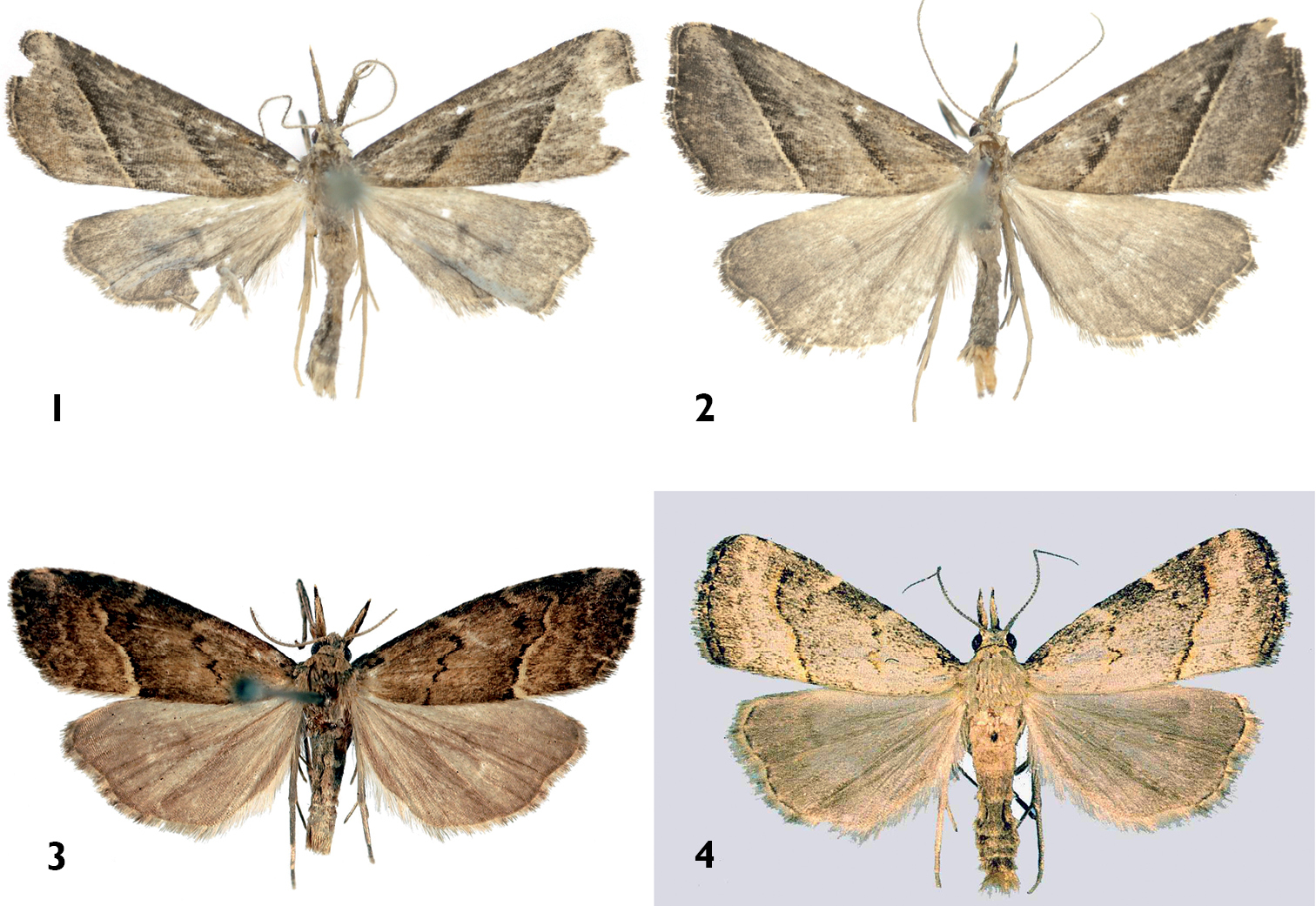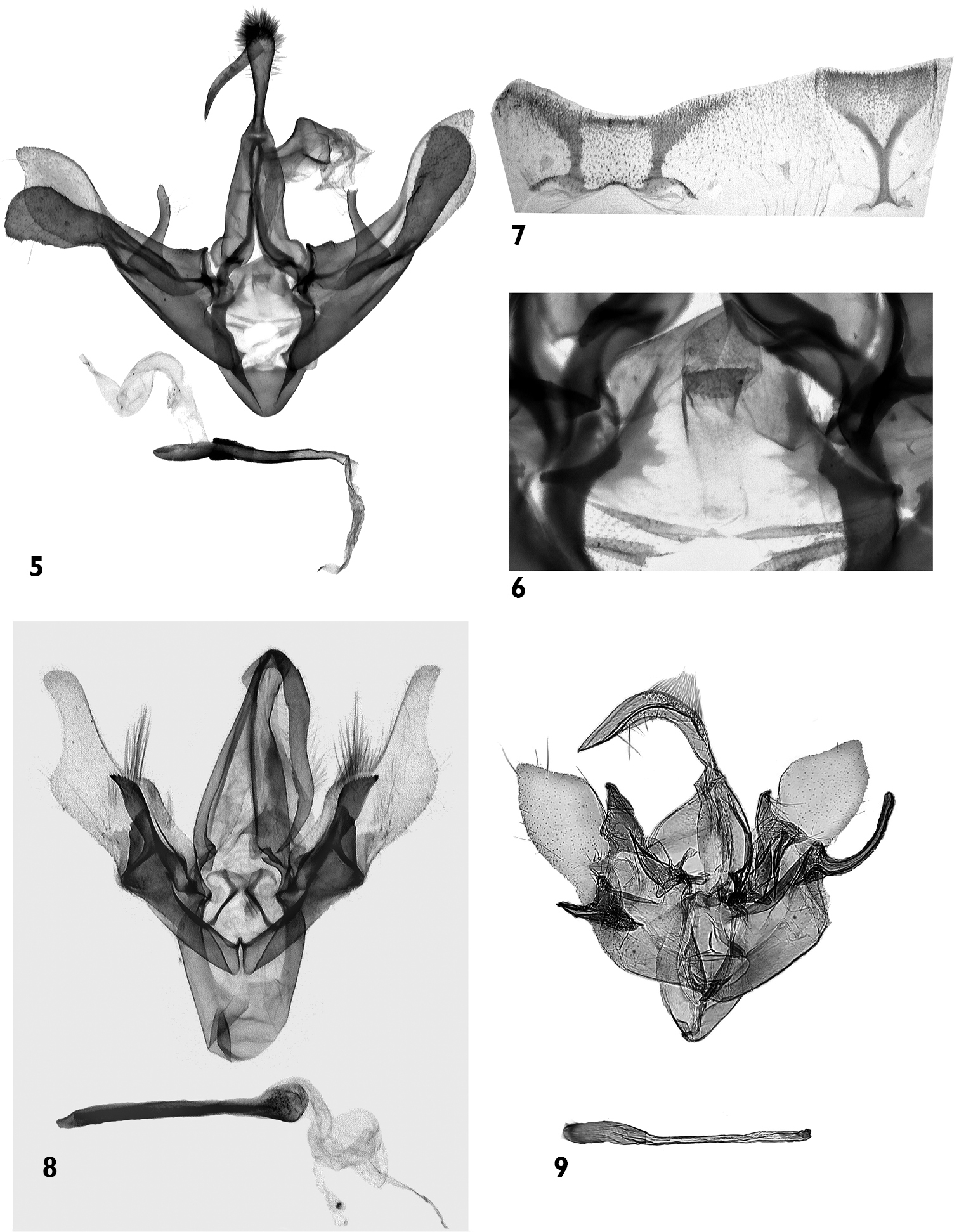






(C) 2012 Oleg Pekarsky. This is an open access article distributed under the terms of the Creative Commons Attribution License 3.0 (CC-BY), which permits unrestricted use, distribution, and reproduction in any medium, provided the original author and source are credited.
For reference, use of the paginated PDF or printed version of this article is recommended.
A new species of the genus Schrankia Hübner, 1825, S. pelicano sp. n. is described from Sichuan, China. A diagnostic comparison is made with Schrankia taenialis (Hübner, [1809]) and Schrankia separatalis (Herz, 1904); illustrations of the male holotype and its genitalia are provided. A checklist of the genus with synonyms is given.
Lepidoptera, Erebidae, Schrankia, new species, China
Schrankia Hübner, 1825 is a widespread genus of Erebidae, being distributed in the Northern hemisphere, the Oriental and Australasiatic regions. It is represented by three species in Europe (
http://species-id.net/wiki/Schrankia
Figs 3, 8The genus Schrankia is characterized by the slender body and narrow, weakly sclerotized wings, light-brown ground color of the forewing and abdomen, long, straight labial palps, which are three to four times as long as the diameter of the eye (
urn:lsid:zoobank.org:act:033BC935-14EC-4A82-B753-15C530773B3D
http://species-id.net/wiki/Schrankia_pelicano
Figs 1, 2, 5–7Holotype male. China, Sichuan, 29°52.808'N, 102°50.240'E, near Ying Jing, bamboo forest, 700 m, 4.IV.2011, leg. Floriani; slide No.: OP1429m (coll. O. Pekarsky, deposited in the HNHM Budapest). Paratypes. China, Sichuan: 4 ♂♂, with same data as the holotype (coll. A. Saldaitis, Vilnius); 1 ♂ (coll. O. Pekarsky); 1 ♂ (coll. W. Speidel, Munich).
The species name refers to the resemblance of the opened male genitalia to a pelican.
The new species possesses a number of the diagnostic characters of the genus Schrankia (e.g., absence of ocelli; long, straight palpi; wide valval base; presence of medial complex of processes; thin, elongated aedeagus). The autapomorphic features of Schrankia pelicano are the very long palpi, being much longer than in other species of Schrankia, the biarticulate uncus, the extremely large sacculus, which is almost equal in size and similar in shape to the distal half of the valva. Considering the diagnostic characters mentioned previously, the new species is placed into Schrankia, but its generic position could change through a much needed revision of the entire genus. Among Schrankia, the new species is closest to the Oriental group of species known from Korea and Japan, Schrankia separatalis, Schrankia dimorpha, Schrankia kogii, Schrankia masuii and Schrankia seinoi. This species-group is characterized by the flat, thin, weakly sclerotized (almost transparent) distal half of valva, which has a rounded apex, wider and more strongly sclerotized haunch-like valval base, the well-developed apical saccular projection, and the less broadened caecum. The numerous autapomorphic features of the male genitalia of the new species (Figs 5–7) make it difficult to determine its closest relative within Schrankia. The comparison is provided here with Schrankia taenialis (Fig. 8), the type-species of the genus and Schrankia separatalis (Fig. 9), the most similar representative of the Oriental group of species. Schrankia pelicano is similar externally to Schrankia taenialis and Schrankia separatalis (Fig. 4) but has longer labial palpi, narrower, more elongated forewing with a less acute apex and straight, almost parallel crosslines without undulations or dentations. The male genitalia of Schrankia pelicano differ from those of the related species by the long and narrow, subapically constricted valva, very large sacculus, digitiform ampulla, and basally clavate uncus with a long, narrow, acute distal part. Schrankia taenialis (Fig. 8) has a narrow valva with an acute apex, a large and broad ampulla and a long uncus. The genitalia of Schrankia separatalis have, in comparison with Schrankia pelicano, short and wide valva with small sacculus and much thicker, continuously curved uncus having half-cylindrical cross-section (Fig. 9).
Adults. 1–2 Schrankia pelicano sp. n. 1 holotype male, China 2 paratype male, China 3 Schrankia taenialis male, Hungary 4 Schrankia separatalis male, Korea.
Male (Figs 1, 2). Wingspan 16–17 mm, length of forewing 8 mm. Head, thorax and abdomen ochreous grey; ocelli absent; tongue well developed; palpi very long (almost 5 times longer than diameter of eye), straight, 2nd segment (with appressed scales) about 2.8 times longer than 3rd segment, which is porrect; antenna with fine ciliation ventrally along full length, basal joint without pectination. Forewing elongate, narrow with acute apex, outer margin with rounded termen; ground color grey brown; costa straight with five milk-white patches; basal line barely visible, semicircular; antemedial line black, straight, oblique, curved upward near costa; postmedial line black, straight, oblique, extending from 2/3 from base on hind margin of wing to 9/10 from base on costal margin, edged on outer side by narrow yellow postmedial fascia; subterminal line faint, pale, irregular, parallel to outer margin of wing; terminal line black, most prominent between wing veins; cilia yellow at base with dark medial line, grey distally. Hindwing ochreous grey, discal spot grey, terminal line black; cilia pale yellow at base, grey distally. Abdomen slender, long. Female unknown.
Male genitalia (Figs 5–7). Uncus biarticulate, consisting of clavate and setose main part and long, narrow, subapically curved, bill-like extension with pointed tip; tegumen narrow, as long as vinculum; scaphium well sclerotized, distally dilated; subscaphium membranous; juxta large, triangular, wider at base, weakly sclerotized (almost transparent), with two narrow, strongly sclerotized lateral plates with serrated inner edges (Fig. 6); vinculum strong, cup shaped. Valva elongated, conspicuously constricted subapically; cucullus almost rounded with acute tip; corona absent; sacculus very large, elongated, with very long, heavily sclerotized, distally dilated saccular extension, almost as long as distal half of valve; clavus unspecialised; clasper/ampulla complex large, sclerotized, setose, cuneate with broad base and finely pointed apex. Aedeagus tubular, thin and gracile, finely undulate. Vesica relatively short (shorter than aedeagus), thinly tubular (as broad as average width of aedeagus), with fine granulose scobination throughout.
Male genitalia. 5–7 Schrankia pelicano sp. n., holotype, China, slide No. OP1429m 5 clasping apparatus and aedeagus with vesica inverted 6 juxta (medially enlarged) 7 8th abdominal segment 8 Schrankia taenialis Hungary, slide No. 10059 RL 9 Schrankia separatalis Korea, slide V. Kononenko.
The species is known only from the type-locality, South-West China, Province Sichuan.
Checklist of Schrankia
Europe
Schrankia taenialis (Hübner, [1809]) TL: Europe
syn. albistrigatis Haworth, 1809 [TL: Britain]
Schrankia costaestrigalis (Stephens, 1834) TL: Wittlesea Mere, Swaffham, Norfolk
syn. exsularis Meyrick, 1888 TL: New Zealand, Taranaki
syn. triangulalis Hudson, 1923
syn. costistrigalis Dannehl, 1925 [TL: Italy]
syn. lugubralis Dannehl, 1925 TL: South Tirol, Italy
syn. monotona Lempke, 1949 [TL: Holland]
syn. unicolor Lempke, 1949 [TL: Holland]
syn. virgata Lempke, 1966 [TL: Holland]
syn. hartigi Berio, 1991 TL: Sardinia
Schrankia balneorum (Alphéraky, 1880) TL: N. Caucasus
syn. bosporella Budashkin & Klyuchko, 1990 TL: Crimea
Africa
Schrankia solitaria Fletcher, 1961 TL: Ruwenzori, Mahoma River [Uganda]
Schrankia microscopica (Berio, 1962) TL: Aldabra Islands [Seychelles]
Schrankia namibiensis Hacker, 2004 TL: Namibia, Brandberg, Am Königstein
Schrankia scoparioides Hacker, 2004 TL: Namibia, Brandberg, Hungarob-valley
Asiatic region
Schrankia obstructalis (Walker, [1866]) TL: Sarawak [Malaysia]
Schrankia croceipicta (Hampson, 1893) TL: Ceylon, Pundaloya
syn. croceipicta aegrota Berio, 1962; 179, TL: Seychelles, Mahe B., Vallon
Schrankia aurantilineata (Hampson, 1896) TL: Ceylon
Schrankia separatalis (Herz, 1904) TL: Korea
syn. squalida Wileman & South, 1917; 28, TL: Japan
Schrankia dimorpha Inoue, 1979 TL: Kagawa Pref., Shinoe, Fudodaki [Japan]
Schrankia kogii Inoue, 1979 TL: Hokkaido, Shintoku, Kuttari
Schrankia masuii Inoue, 1979 TL: Kagawa Pref., Shinoe, Oyashiki [Japan]
Schrankia seinoi Inoue, 1979 TL: Amami-Oshima Is., Sumiyoson [Japan]
Schrankia bilineata Galsworthy, 1997 TL: Hong Kong
Schrankia pelicano sp. n. TL: China, Sichuan
Schrankia bruntoni Holloway, 2008 TL: Ulu Temburon, Brunei
Schrankia dusunorum Holloway, 2008 TL: Sabah, Ulu Dusun, 30mls W of Sandakan [Malaysia]
Schrankia spiralaedeagus Holloway, 2008 TL: Sarawak, Gunong Mulu Nat. Park [Malaysia]
Australasiatic region
Schrankia calligrapha Snellen, 1880 TL: New Hebrides, Aneityum, Red Crest, 3 km NE of Anelgauhat
Schrankia taona (Tams, 1935) TL: Samoa, Savaii
Schrankia capnophanes (Turner, 1939) TL: Tasmania, Mt. Wellington
Schrankia dochmographa Fletcher, 1957 TL: Solomon Is., Rennell I., Hutuna
Schrankia furoroa Robinson, 1975 TL: Fiji, Rotuma, Furoroa
Schrankia vitiensis Robinson, 1975 TL: [Fiji]
Schrankia boisea Holloway, 1977 TL: New Caledonia, Port Boise
Schrankia cheesmanae Holloway, 1977 TL: New Hebrides, Aneityum, Red Crest, 3 km NE of Anelgauhat
Schrankia daviesi Holloway, 1977 TL: Norfolk Is., N. Mission Road
Schrankia erromanga Holloway, 1977 TL: New Hebrides, Erromango I., Nouankao Camp
Schrankia karkara Holloway, 1977 TL: New Guinea, Karkar I., Dampier I.
Schrankia nokowula Holloway, 1977 TL: New Hebrides, Sanot, Mt. Tabwemasana, Nokowula
Schrankia nouankaoa Holloway, 1977 TL: New Hebrides, Erromango I., Nouankao Camp
Schrankia tabwemasana Holloway, 1977 TL: New Hebrides, Santo, Mt. Tabwemasana, Nokowula
Schrankia tamsi Holloway, 1977 TL: Samoa, Upolu I., Mt. Vaea
Neotropical region
Schrankia macula (Druce, 1891) TL: Panama, Chiriqui
Schrankia flualis (Schaus, 1916) TL: Panama, Trinidad River
Schrankia musalis (Schaus, 1916) TL: Panama, Trinidad River
Oceanian region
Schrankia altivolans (Butler, 1880) TL: Hawaii, Mauna Loa
syn. simplex (Butler, 1881) TL: Hawaii
syn. oxygramma (Meyrick, 1899) TL: Kaua, Kaholuamano [Hawaii]
syn. sarothrura (Meyrick, 1899) TL: Hawaii, Ola
syn. arrhecta (Meyrick, 1904) TL: Hawaii, Mt. Waimea
Schrankia howarthi Davis & Medeiros, 2009 TL: Hawaii
I would like to express my sincere thanks to Aidas Saldaitis for access to his collection; to László Ronkay for his critical comments on the manuscript, to Gábor Ronkay for the image of Srankia taenialis, Jürgen Schmidl for help with finding literature and to Vladimir Kononenko for the images of Schrankia separatalis, help with finding literature, valuable suggestions and critical comments on the manuscript.

